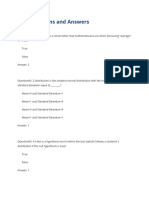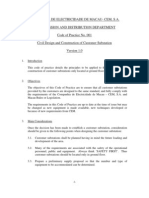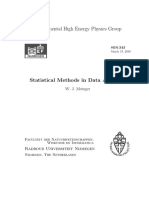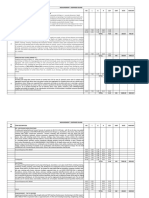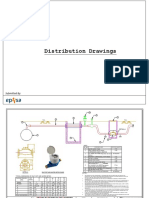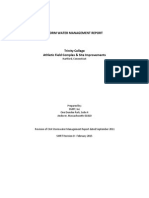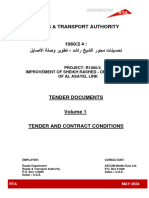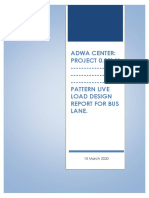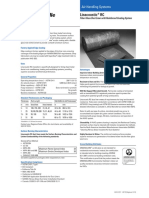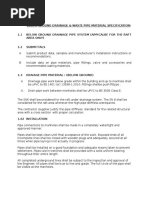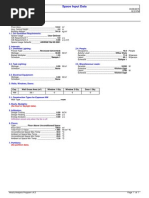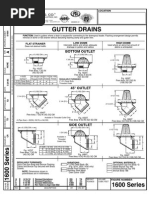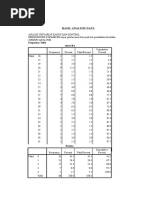UAE Rainfall
UAE Rainfall
Uploaded by
raghuragooCopyright:
Available Formats
UAE Rainfall
UAE Rainfall
Uploaded by
raghuragooOriginal Description:
Copyright
Available Formats
Share this document
Did you find this document useful?
Is this content inappropriate?
Copyright:
Available Formats
UAE Rainfall
UAE Rainfall
Uploaded by
raghuragooCopyright:
Available Formats
INTERNATIONAL JOURNAL OF CLIMATOLOGY
Int. J. Climatol. 34: 1318–1328 (2014)
Published online 26 June 2013 in Wiley Online Library
(wileyonlinelibrary.com) DOI: 10.1002/joc.3768
Analysis of rainfall, PMP and drought in the United Arab
Emirates
Mohsen Sherif,a* Mohamed Almulla,b Ampar Shettya and Rezaul K. Chowdhurya
a Department of Civil and Environmental Engineering, United Arab Emirates University, Al Ain, United Arab Emirates
b Water Resources Division, Ministry of Environment and Water, Dubai, United Arab Emirates
ABSTRACT: Spatial and temporal characteristics of rainfall in the United Arab Emirates (UAE) were investigated. The
region is divided into four climate zones (East Coast, Mountains, Gravel Plains and Desert Foreland) of distinguished
rainfall distribution. The rainfall patterns, rainfall probability of occurrences, rainfall intensity-duration-frequency (IDF)
relationship, probable maximum precipitation (PMP) and drought scenarios were investigated. Daily rainfall data from a
network of stations across the UAE were used. Standard statistical techniques were applied for data analyses. The Gumbel,
log Pearson, generalized extreme value, log normal, Wakeby and Weibull probability distributions were tested to fit extreme
rainfalls. Both Gumbel and Weibull distributions were found adequate. Measures of dispersion and symmetry of rainfall
patterns were found relatively high. The estimated PMP values were found highest in the East Coast region and lowest in
the Gravel Plains region. Estimated drought severity index showed that the regions have similar trends of drought patterns
over the years. The study is useful for sustainable water resources planning and management in the region.
KEY WORDS rainfall; probability distribution; intensity-duration-frequency curves; probable maximum precipitation; drought
Received 17 October 2012; Revised 12 February 2013; Accepted 19 May 2013
1. Introduction have intensities of 20 mm h−1 or less for all return
Understanding the spatial and temporal rainfall charac- periods. The average draught duration in the three
teristics is of special interest from a sustainable water studies wadis was 2.6 years. In semi-arid Australian
resources management point of view (Grum et al., 2006). region, Chowdhury and Beecham (2010, 2012) and
Investigating rainfall variability at the regional scale is Beecham and Chowdhury (2010) analysed spatial and
essential for investigation of potential impacts on humans temporal rainfall behaviour using high-resolution (6
and the natural environment. Several studies have been min) rainfall data. Many design storm events in urban
carried out in order to identify spatial and temporal catchments have times of concentration of about 15–30
characteristics of rainfall (Ventura et al., 2002). Most of min (O’Loughlin et al., 1995). Therefore investigation
these studies were carried out at the annual, seasonal or on short duration rainfall intensities is significantly
monthly temporal scales. For the sustainability of urban important for urban water and flash flood management.
water management, planners and engineers are interested Water resources management in arid- and semi-arid
in what is happening at the finer temporal scales. Flash regions is significantly constrained by limited, unreliable
floods in arid region is a potential hazard to life, property and high degree of spatial and temporal variability of
and hydraulic structures such as bridges, culverts, wells, rainfalls. The spatial temporal variability of rainfall
dykes and small dams along wadi courses (Subyani, affects their overall hydro-climatic conditions such as
2011). Investigation on flash floods requires spatial and drought, flood, streamflow and groundwater recharge.
temporal characterization of rainfalls. Several studies Accurate information on rainfall characteristics is
were conducted on rainfall characterization in arid and essential in the design of stormwater best management
semi-arid regions. Subyani (2011) and Almazroui et al. practices, which is also known as the Sustainable Urban
(2012) recently investigated rainfall characterization in Drainage Systems and Water Sensitive Urban Design
Saudi Arabia (arid region). Sherif et al. (2009, 2011) in some countries (Beecham and Chowdhury, 2012).
investigated rainfall properties in three wadi catchments Agricultural practices and irrigation schemes require
in the United Arab Emirates (UAE). They concluded information on rainfall characteristics and drought
that rainfall events with durations of 2.5 h or more conditions (Sherif et al., 2009). Harvesting of alternative
water resources such as rainwater, stormwater and
reclaimed grey water requires rainfall information as a
* Correspondence to: Department of Civil and Environmental Engineer- primary input variable (Fletcher et al., 2007). Rainfall
ing, United Arab Emirates University, Al Ain, United Arab Emirates.
E-mail: msherif@uaeu.ac.ae
characterisation is also becoming very important for
rainfall forecasting in the context of climate change
2013 Royal Meteorological Society
RAINFALL, PMP AND DROUGHT IN THE UAE 1319
and variability. In water scarce regions like the Arabian differs from one wadi to other based on their topography,
Peninsula, water systems are particularly vulnerable to hydrogeology and headwater catchments. In mountains
population growth and climate change. Severe intensity region, infiltration of rainfalls into wadi beds is low and
rainfall events can cause failure of drainage systems flash floods result from heavy rainfalls. Flash floods are
capacity and subsequent flood inundation problems. This fairly common in arid regions (Subyani, 2011). However,
is especially important in mountainous regions where their occurrences depend on the interaction between
the variations tend to be large. geological and morphological characteristics (elevation,
Rainfall and runoff deficits have been observed in the slope, sediment transport etc.) and hydro-meteorological
UAE over the last couple of decades and consequently phenomena such as rainfall, runoff, evaporation and
drought was persisted (Al-Rashed and Sherif, 2000). groundwater storages (Nouh, 2006). In the UAE, most
Annual rainfall in the region has reduced significantly of annual rainfalls reach the Gravel Plain region which,
since 1998 (Sherif et al., 2009). In arid regions such in some cases, corresponds to a relatively high annual
as the UAE, groundwater recharge from the ephemeral runoff. In the piedmont areas, both infiltration and runoff
wadi beds and subsurface flow from mountainous val- are generally observed. Therefore, heavy rainfalls may
ley beds play an important role in water management. give rise to runoff, even in a fairly permeable zone
The quantification of groundwater recharge is a prereq- (Gravel Plain region). A large part of annual rainfalls in
uisite for efficient and sustainable groundwater resources the Gravel Plain region flows out into the Desert region.
management in arid regions. Successful implementation Runoff is almost inexistent in the Desert zone.
of water resources planning requires knowledge of the
space, time and frequency of rainfalls and their character-
3. Data and methods
istics. Design and risk analysis of water storage structures
are generally based on extreme events of rainfall. Design Rainfall is the most important factor affecting hydraulic
rainfalls are generally expressed in a form called the rain- characteristics of wadi catchments. Raingauge stations in
fall intensity-duration-frequency (IDF) curves. Lack of the UAE are sub-divided into four major regions namely,
availability of high-resolution long record of rainfall data Mountains, East Coast, Gravel Plain and Desert Foreland
is a major constraint for developing IDF curves in the regions (Figure 1). A total of 42 rain gauge stations
region (El-Hadji and Singh, 2002). were selected based on the availability of good quality
Characterization of rainfall patterns in the whole of of daily rainfall data. These rain gauges are spatially
the UAE region has not yet been investigated. This distributed across all four regions such as East Coast
information is still lacking in the Middle East region. A (5 stations), Mountains (17 stations), Gravel Plain (13
review of research on tropical rainfall characterization stations) and Desert Foreland (7 stations) area. Rainfall
revealed that most of detailed studies were conducted data were collected from 1966–1967 to 2009–2010 from
for the humid regions (Jackson, 1977). Whilst few the Ministry of Environment and Water (MOEW). Spatial
studies were conducted on the UAE rainfall charac- locations of main rain gauges are shown in Figure 1.
terization, most of these were spatially extended to Spatial homogeneity test of rainfall data was conducted
a few wadi catchments (Sherif et al., 2011). In this using the double mass curve technique, and it was
study, rainfall characteristics in the UAE are explored. found that data are homogeneous. The Buishand’s Q
Statistical moments of rainfalls, probability distributions test (Buishand, 1982) on 24-h maximum rainfall data did
of extreme rainfalls, PMP, IDF curves and drought not identify temporal non-homogeneity in data sets. The
severity index (DSI) were developed. Their spatial and percentage of missing data in some stations vary from 2
temporal variations were also investigated. The resulting to 3%. The missing values were filled using information
information serves as baseline data for several activities from nearby stations (double mass curve). Outliers were
including rehabilitation projects, irrigation scheduling, not identified in the data series. The weighted average
and hydrological studies such as design of dams and technique was followed in the estimation of average
mitigation of possible flood hazardous. rainfall of different rainfall zones.
Statistical moments (mean, standard deviation, skew-
ness coefficient and kurtosis coefficient) of annual
2. Description of study area
rainfalls were estimated for all stations. Correlation
The study area, the UAE is located in the southeastern coefficient of rainfalls between four regions, proba-
part of the Arabian Peninsula between UTM coordinates bility distribution of rainfalls, return periods and data
2883648 Northing 40 R and 2503242 Northing 40 Q and consistency were analysed. Empirical relations for the
559185 Easting 39 R and 437054 Easting 40 R (Figure estimation of annual rainfall and the maximum daily rain-
1). The total area of the UAE is about 83 600 km2 . fall amount at different return periods were developed for
Its geomorphologic features include mountains, gravel all four regions. The 24-h annual maximum and the mean
plains, sand dunes, costal zones and drainage basins annual rainfall data for all regions were analysed for
(Boer, 1997). More than 75% of the area is covered estimating the expected rainfall at different return periods
by the desert. Climate of the UAE is arid. The entire using the generalized extreme value (GEV), lognormal,
region is mostly dry throughout the year but surface Gumbel, log Pearson, Wakeby and Weibull distributions.
runoff generates during rainy seasons. Runoff generation The conventional method of moments was applied to
2013 Royal Meteorological Society Int. J. Climatol. 34: 1318–1328 (2014)
1320 M. SHERIF et al.
Figure 1. Location map of the study area (the United Arab Emirates), its four major zones and spatial locations of main rainfall stations.
estimate their distribution parameters. The Weibull plot- estimation assumes a stationary mean and standard devi-
ting position formula was applied (Singh, 1992). Drought ation over time. The cumulative frequency distributions
conditions were investigated by the estimation of DSI. can be used for the development of IDF curves (Chow
Rainfall IDF relationships were developed based on et al., 1988). In this study, IDF curves were developed
probability distributions. Techniques used for statistical using annual 24-h maximum rainfall series for all sta-
analyses of rainfall data are described in WMO (2009a) tions using the Gumbel distribution. The Gumbel dis-
and Salas (1993). It is generally assumed that a hydro- tribution is one of the most widely applied probabil-
logical variable generally follows a certain distribution ity density function (pdf) in calculating extreme val-
type. Some of the most common and important prob- ues in hydro-meteorological studies. Log Pearson type
ability distributions used in hydrology are the normal, 3 distribution is also used for extreme value analysis in
lognormal, gamma, log Pearson, Weibull and Gumbel some regions (semi-arid Australian regions, for example)
distribution. The Weibull and Gumbel distributions (ARR, 2001). Gumbel distribution was also applied in
are generally used for extreme values of hydrological the Arabian Peninsula regions (Subyani, 2011). Descrip-
variables. Description of these distributions and methods tion of Gumbel distribution is available in Salas (1993).
of parameter estimation are available in Salas (1993). Lack of availability of short duration rainfalls is a con-
Conventionally rainfall data are presented as IDF straint for developing IDF curves. Rainfall disaggregation
curves which are generally derived from point rainfall techniques are generally applied to convert daily rain-
frequency analysis of annual maximum rainfall series for falls into sub-hourly and sub-daily durations. Empirical
durations ranging from 5 min to 24 h. Rainfall intensity equations are also used to convert 24-h annual maximum
(I ) for a given return period (T ) can be estimated using rainfalls into short duration rainfalls. Empirical equations
the method of moments: were previously applied for IDF curves development for
IT = I + (KT ) S (1) regions where short duration rainfall data are not avail-
able. In this study, the empirical ratios of n-duration rain-
fall to 60-min rainfall, recommended by WMO (2009b),
where, I is the mean, S the standard deviation and KT were used to estimate short duration rainfalls. The ratios
a frequency factor that depends on return period and are, for example, 0.29 (5 min), 0.45 (10 min), 0.57 (15
type of statistical distribution used. The method of IDF min) and 0.79 (30 min). According to WMO (2009b),
2013 Royal Meteorological Society Int. J. Climatol. 34: 1318–1328 (2014)
RAINFALL, PMP AND DROUGHT IN THE UAE 1321
the percentage of error of using these ratios in rainfall 4. Results and discussion
disaggregation is about 10% and their application is rec-
4.1. Rainfall patterns
ommended for data scarce regions.
According to WMO (2009a), PMP can be defined as The average annual rainfall departure in the UAE from
the greatest depth of precipitation for a given duration their long-term mean value is presented in Figure 2.
meteorologically possible for a given size storm area at It is found that from 1966 to 1998, average annual
a particular time of year, with no allowance made for rainfall variation in the UAE was evenly distributed.
long-term climate trends. Several techniques of PMP esti- Relatively high rainfall amounts were observed for the
mation are available based on availability of rainfall data, period 1995–1998. It is also noticed that once in 2 or
catchment size and location and meteorological condi- 3 years, annual rainfall is exceeded the normal rainfall
tions responsible for extreme rainfalls (Casas et al., 2008, (long-term average). However, after 1998, rainfall has
2011). The statistical method of PMP estimation devel- decreased. The range of the departure varies from 273
oped by Hershfield (1961a, 1961b) and later modified to 103 mm. The highest rainfall occurred in the years
by Hershfield (1965) have been applied in this study. 1995–1996 and lowest in the years 1999–2000. The
The method is based on frequency analysis of annual UAE is successively experiencing deficit of rainfall since
maximum rainfall series. According to Chow (1961), the 1999. The reason behind this deficit of recent rainfalls
general frequency equation is in the UAE has not yet been analysed. The influence
of atmospheric-ocean circulation on rainfalls may be an
PMP = P n + Km Sn (2) effective factor. However sufficient research has not been
conducted on this issue.
PM − P n−1 Figure 3 shows the average annual rainfall for four
Km = (3) regions. Interestingly, all four regions exhibit similar
Sn−1
rainfall pattern; however, magnitude varies between the
where, Pn , P M and S n are the mean value, the highest regions. The lowest rainfall is observed in the desert
value and standard deviation, respectively, for a series foreland and highest rainfall is observed in the mountains
of n annual maximum 24-h rainfalls; Pn−1 and S n − 1 and east coast regions. The estimated mean annual
are the mean and the standard deviation respectively for rainfall of east coast is about 97%, gravel plain is
the series excluding the highest value from the series; 84%, desert foreland is 60% and the UAE rainfall
K m is the frequency factor. Hershfield (1961a, 1961b) is 83% of annual mean rainfall of mountain area.
found K m = 15 by analysing 2645 rainfall stations in the Correlation between average annual rainfalls of the
United States of America; later Hershfield (1965) found UAE and other regions were performed in order to
the value 15 is too high for rainy areas and too low for understand their interrelationship. Figure 4 shows their
arid areas and too high for rain durations less than 24 correlations. Gravel plain rainfall exhibits the maximum
h. The estimated PMP values were adjusted in order to correlation (R 2 = 0.96) with the average rainfall in the
correct for the use of a fixed observational time interval of UAE. Rainfalls in the east coast and mountain areas are
24 h. WMO (2009b) recommended an adjustment factor generally higher than the average rainfall in the UAE. On
of 1.13 for 24-h duration rainfall. Recent research in the other hand, rainfalls in the desert area are less than
the United Kingdom recommended an adjustment factor the average rainfall in the UAE and also to other regions.
of 1.167 (Dwyer and Reed, 1994). A lesser adjustment
factor (AF) is required when the maximum observed 4.2. Statistical behaviours of rainfalls
rainfall amounts for various durations are determined The statistical analysis of annual maximum daily rainfall
from two or more fixed time intervals (Weiss, 1964; and annual mean rainfall series of all rain gauge stations
NRCC, 1989). Therefore, an AF of 1.01 was considered were carried out. The statistical results are presented
in this study. The values of K m considered in the study in Table 1. Annual rainfall of East Coast ranges from
are based on WMO (2009b) and are shown in Table 5. 6.4 to 531.5 mm. Mean rainfall estimated based on the
The relationship between drought intensity, duration records of 45 years is 124.0 mm with a standard deviation
and frequency can be analysed using the conceptual of 104.9 mm, kurtosis coefficient 4.35, coefficient of
model developed by Ponce et al. (2000). The conceptual variation 0.85 and coefficient of asymmetry 1.78. One-
approach is applicable to sub-tropical and mid-latitudinal day annual maximum rainfall of east coast ranges from
regions, and is limited to meteorological droughts lasting 6.8 to 151.5 mm. Mean one-day annual maximum rainfall
at least 1 year. For any year for which P is the annual estimated for 26 years is 52.8 mm with standard deviation
precipitation, DSI is defined as the positive ratio of 38.1 mm, kurtosis coefficient 1.1, coefficient of variation
the deficit (P ma − P ) to the mean (P ma ). For any 0.70 and coefficient of asymmetry 1.3.
particular year, the ratio of [(P ma − P )/P ma ] = 0.25 In the mountains region, annual rainfall ranges from
is classified as moderate; 0.5 is severe, and 0.75 and 6.7 to 418.3 mm. Average annual rainfalls estimated for
above is extreme. For drought events lasting more than 45 years is 131.9 mm with a standard deviation of 106.2
1 year, intensity is the summation of the individual mm, kurtosis coefficient 0.52, coefficient of variation
annual intensities. Therefore, extreme drought intensities 0.81 and coefficient of asymmetry 1.12. One-day annual
are generally associated with droughts of longer duration. maximum rainfall of mountain region ranges from 4.2
2013 Royal Meteorological Society Int. J. Climatol. 34: 1318–1328 (2014)
1322 M. SHERIF et al.
Figure 2. Departure of areal average annual rainfall in the UAE with respect to their long-term mean value.
Figure 3. Variation of areal average annual rainfall between four zones (East Coast, Mountain, Gravel Plain and Desert Foreland).
mm to 126.1 mm. Mean one-day annual maximum The skewness coefficient measures the asymmetry of
rainfall estimated for 26 years is 45.0 mm with standard the frequency distribution of the data. The skewness
deviation of 27.5 mm, kurtosis coefficient 2.2, coefficient coefficient has an important meaning as it gives indication
of variation 0.6 and coefficient of asymmetry 1.3. of the symmetry of the distribution of the data (Salas,
In the Gravel Plain, annual rainfall ranges from 10.6 1993). Symmetrical frequency distributions have very
mm to 349.7 mm. Average annual rainfall estimated for small or negligible sample skewness coefficient (C s ),
45 years is 107.7 mm with a standard deviation of 80.6 while asymmetrical frequency distributions have either
mm, kurtosis coefficient 0.48, coefficient of variation positive or negative C s . A small value of C s often
0.75 and coefficient of asymmetry 1. One-day annual indicates that frequency distribution, of the sample, may
maximum rainfall of gravel plain ranges from 10.5 to 84.5 be approximated by the normal distribution function
mm. Mean one-day annual maximum rainfall estimated as C s = 0 for this function. The kurtosis coefficient
for 26 years is 39.1 mm with standard deviation 19.9 mm, measures the peakedness or the flatness of the frequency
kurtosis coefficient −0.2, coefficient of variation 0.5 and distribution near its centre. The positive value of an
coefficient of asymmetry 0.6. excess coefficient (Kurtosis coefficient = 3) indicates that
In the Desert Foreland, annual rainfall varies from a frequency distribution is more peaked around its centre
1.8 to 231.7 mm. Average annual rainfall estimated for than the normal distribution. The negative value of an
45 years is 74.9 mm with a standard deviation of 59.5 excess coefficient indicates that a given distribution is
mm, kurtosis coefficient −0.07, coefficient of variation more flat around its centre than the normal.
0.79 and coefficient of asymmetry 0.85. One-day annual All stations have exhibited highly variable annual rain-
maximum rainfall of Desert Foreland ranges from 0.2 fall in nature over the period. The variability and incon-
to 100.1 mm. Mean one-day annual maximum rainfall sistency in rainfall in the area are clearly substantiated
estimated for 26 years is 34.4 mm with standard deviation by their standard deviation and coefficient of variation in
22.9 mm, kurtosis coefficient 1.5, coefficient of variation the range of 59.52 to 106.2 mm and 0.75 to 0.85, respec-
0.7 and coefficient of asymmetry 1.0. tively. The maximum Kurtosis coefficient estimated for
2013 Royal Meteorological Society Int. J. Climatol. 34: 1318–1328 (2014)
RAINFALL, PMP AND DROUGHT IN THE UAE 1323
Figure 4. Relationship between average annual rainfall of the UAE and other regions (East Coast, Mountains, Gravel Plain and Desert Foreland).
Table 1. Estimated statistical moments of annual and 24-h maximum rainfalls.
Region
East Coast Mountain Gravel Plain Desert Foreland UAE average
a
Parameter Annual 24-h max Annual 24-h max Annual 24-h max Annual 24-hmax Annual 24-h max
Maximum (mm) 531.5 151.5 418.3 126.1 349.7 84.5 231.7 100.1 382.8 115.5
Minimum (mm) 6.4 6.8 6.7 4.2 10.6 10.5 1.8 0.2 7.0 5.5
Mean (mm) 124.0 52.8 131.9 45.0 107.7 39.1 74.9 34.4 109.6 42.8
Standard deviation (mm) 104.9 38.1 106.2 27.5 80.6 19.9 59.5 22.9 84.0 25.8
Skewness coefficient 1.78 1.3 1.12 1.3 1.00 0.6 0.85 1.0 1.15 1.1
Kurtosis coefficient 4.35 1.1 0.52 2.2 0.48 −0.2 −0.07 1.5 1.18 1.5
a 24-h max is 24-hour maximum.
the East Coast region is 4.35. The value less than 3.0 inter-annual variability in annual rainfalls in Saudi Ara-
represents a distribution has a relatively smaller concen- bia. Chowdhury and Beecham (2010) observed high tem-
tration of a probability near the mean than does the nor- poral variability of South Australian (semi-arid region)
mal or otherwise. Skewness is in the range of 0.85–1.75 rainfall.
which indicates the positively skewed distribution of very
low frequency of occurrences of higher magnitude rain-
falls and more number of occurrences of annual rainfall 4.3. Probability distributions of rainfalls
lower than mean values. The regression models for return period and annual and
The pattern of occurrence of rainfall in the Gravel maximum daily series were developed and presented in
Plain and Desert Foreland is very close to each other the Table 2. Using the equation presented in Table 2, the
as indicated by their skewness coefficient. High vari- 24-h duration rainfall intensity and frequency curves for
ability of one-day annual maximum rainfall was also different rainfall zones in the UAE are shown in Figure 5.
observed in all regions. Kurtosis coefficient in the range Estimated probability distribution parameters and good-
of −0.2 to 2.2 (less than 3.0) represents a distribu- ness of fit for average annual rainfalls are provided in
tion with relatively smaller concentration of probability Table 3 for four regions. Similarly, Table 4 represents the
close to mean value. The frequency distribution of one- same parameters for the 24-h annual maximum rainfalls.
day annual maximum rainfall also exhibits positively Estimated annual rainfall is found comparatively high in
skewed distributions (skewness 0.6–1.3). The patterns mountain region and low in the desert foreland. In the
of occurrences of rainfall in the East Coast, Mountains case of maximum annual daily rainfall, the east coast
and Desert Foreland are very similar to each other as region exhibits higher rainfall amounts than compared
indicated by their skewness. Few previous studies in arid with other regions. Higher intensity storms are expected
and semi-arid regions also explored the high variability in to occur in the east coast region than in the mountain
observed rainfalls. Almazroui et al. (2012) observed high areas. The annual maximum 24-h rainfall distribution is
2013 Royal Meteorological Society Int. J. Climatol. 34: 1318–1328 (2014)
1324 M. SHERIF et al.
Table 2. Regression model for annual and 24-h maximum rainfalls and return periods.
Region Rainfall, R (mm) Return period, T (year)
East Coast Annual R = 117.561 ln(T ) + 11.216 T = e[(R−11.216)/117.561]
24-h maximum R = 45.132 ln(T ) + 10.578 T = e[(R−10.578)/45.132]
Mountain Annual R = 119.350 ln(T ) + 17.381 T = e[(R−17.381)/119.350]
24-h maximum R = 32.702 ln(T ) + 14.422 T = e[(R−14.422)/32.702]
Gravel Plain Annual R = 89.978 ln(T ) + 21.409 T = e[(R−21.409)/89.978]
24-h maximum R = 23.542 ln(T ) + 17.012 T = e[(R−17.012)/23.542]
Desert Foreland Annual R = 66.378 ln(T ) + 11.242 T = e[(R−11.242)/66.378]
24-h maximum R = 26.993 ln(T ) + 9.130 T = e[(R−9.130)/26.993]
Figure 5. Twenty-four-hour rainfall intensity and frequency curves for different rainfall zones in the UAE (based on model developed
in Table 2).
found skewed and could not be described by commonly 4.5. Probable maximum precipitation (PMP)
used distributions as indicated by the goodness of fit tests. The PMP magnitudes, together with their spatial and
temporal distributions, are useful for the estimation
4.4. Intensity-duration-frequency (IDF) curves
of probable maximum flood (PMF). Probabilities of
The IDF curves are standard tools of hydrologic risk PMF estimates are used for economic studies and risk
analysis and design (Chow et al., 1988). Average and assessments. It was found that the value of K m vary
peak rainfall intensity and duration of rainfall are the inversely with rainfall. In all the cases the estimated
most important factors affecting the generation of surface K m values were found more than 15, this is because the
water runoff from watersheds. For all four regions, IDF UAE exhibits arid climate. The estimated PMP values at
curves were developed for frequency ranging from 2 to
different K m values and at different adjustment factors are
1000 years (Figure 6). More evidently, Figure 6 shows
presented in Table 5. It is found that the East Coast region
that the shorter duration rainfalls have higher intensity.
exhibits highest PMP values among the regions. The
The eastern region has higher intensity rainfalls com-
Gravel Plain region exhibits least PMP values compared
pared with the other regions. This may be attributed to
the orographic effect due to the presence of mountain with other regions. Figure 7 shows areal distribution of
series very close to the Oman Gulf. In Eastern region, normal annual and mean annual maximum 24-h rainfall
the maximum expected intensity for 2-year return period in the region.
is about 78 mm h−1 for shorter duration rainfall of 5 min. Previous studies developed various depth duration
However for 2-h duration, the intensity is about 14 mm relationships to show rainfall distribution within storms
h−1 . The rainfall intensity for a 1000 year return period (Huff, 1967; Mander et al., 1975, unpublished data). The
of 5 min duration is about 400 mm h−1 and for 2-h dura- depth duration relationship for the Arabian Peninsula
tion is about 70 mm h−1 . It has found that the windward (Kingdom of Saudi Arabia) region developed by Mander
region of eastern mountains experiences higher intensities et al. (1975), unpublished data, was used to develop time
compared with the leeward side of the mountains. The distribution of PMP values for the study area (Tables
Gravel Plains region normally experiences lower rainfall 5 and 6). As per the time distribution adopted, about
intensities as compared with other regions and its range 45% rainfall depth occurs within an hour that follows
is close to the Desert Foreland region’s rainfall intensity. the Natural Resource Conservation Service (NRCS) Type
2013 Royal Meteorological Society Int. J. Climatol. 34: 1318–1328 (2014)
RAINFALL, PMP AND DROUGHT IN THE UAE 1325
Table 3. Estimated probability distribution parameters for annual rainfalls in four rainfall regions.
Probability Parameters and East Coast Mountain Gravel Desert
distribution goodness of fit Plain Foreland
GEV k 0.184 0.175 0.110 0.074
σ 63.881 68.601 56.989 44.533
µ 73.078 78.460 67.953 45.703
K-S testa 0.074 0.103 0.129 0.101
Gumbel σ 81.787 82.832 62.800 46.422
µ 76.776 84.059 74.473 48.118
K-S test 0.094 0.142 0.157 0.106
Log Pearson α 7.305 7.382 18.633 5.438
β −0.364 −0.354 −0.199 −0.454
γ 7.101 7.129 8.091 6.369
K-S test 0.104 0.091 0.104 0.089
Log Normal σ 0.974 0.9517 0.853 1.047
µ 4.439 4.514 4.366 3.901
K-S test 0.145 0.103 0.139 0.119
Wakeby α 204.210 13.080 119.640 −86.272
β 4.994 0.107 0.219 2.772
γ 86.388 0 0 138.350
δ 0.084 0 0 −0.472
ζ −4.444 10.728 09.655 3.844
K-S test 0.076 0.082 0.094 0.062
Weibull α 1.210 1.218 1.365 1.105
β 126.560 138.030 113.260 78.225
K-S test 0.110 0.089 0.117 0.096
a
K-S test is Kolmogorov Smirnov test.
Table 4. Estimated probability distribution parameters for 24-h maximum rainfalls in four rainfall regions.
Probability Parameters and East Coast Mountain Gravel Plain Desert Foreland
distribution goodness of fit
GEV k 0.201 0.116 −0.043 −0.016
σ 23.444 18.990 18.670 73.001
µ 33.541 31.625 23.917 86.220
K-S testa 0.104 0.113 0.060 0.103
Gumbel σ 29.704 21.443 15.553 17.873
µ 35.683 32.660 30.074 24.084
K-S test 0.119 0.137 0.075 0.101
Log Pearson α 11.189 3.139 15.980 0.579
β −2.333 −0.395 −0.142 −1.647
γ 6.322 4.854 5.794 4.108
K-S test 0.116 0.151 0.068 0.171
Log Normal σ 0.764 0.686 0.556 1.227
µ 3.710 3.613 3.525 3.154
K-S test 0.132 0.147 0.101 0.234
Wakeby α 219.810 969.080 169.160 160.070
β 13.297 26.150 13.115 6.992
γ 35.169 25.591 32.140 21.994
δ 0.061 0.084 −0.308 −0.030
ζ 0.0 −17.268 2.473 −6.992
K-S test 0.096 0.102 0.073 0.083
Weibull α 1.445 1.609 2.011 0.797
β 55.645 48.801 42.431 0.42.691
K-S test 0.142 0.132 0.075 0.205
a K-S test is Kolmogorov Smirnov test.
II and Type III patterns (The Type II pattern distributes 4.6. Drought analysis
45% of the total 24-h rainfall in the maximum one hour Drought is a normal and recurrent feature of the climate.
while the Type III pattern distributes 40% of the total It happens in all climatic zones and its characteristics
rainfall in the maximum 1 h). In this study, PMP has vary significantly among regions. It differs from aridity
been developed for region wise. Therefore area reduction in that drought is temporary whereas aridity is a
factors were not considered in the study. permanent characteristic of regions with low rainfall.
2013 Royal Meteorological Society Int. J. Climatol. 34: 1318–1328 (2014)
1326 M. SHERIF et al.
(A) (B)
450 250
East Coast Region Mountain Region
400 1000 yr
350 500 200
INTENSITY (mm/hr) 100
300
50
150
250 20
10
200
5 100
150 2
100 50
50
0 0
0 50 100 150 200 0 50 100 150 200
(C) (D)
250 300
Gravel Plain Region Desert Foreland Region
250
200
INTENSITY (mm/hr)
200
150
150
100
100
50
50
0 0
0 50 100 150 200 0 50 100 150 200
DURATION (Minutes) DURATION (Minutes)
Figure 6. Developed IDF curves for four regions in the UAE (a) East Coast region (b) Mountain region (c) Gravel Plain region and (d) Desert
Foreland region.
Shaam Shaam
2850000 2850000
U. Qwain Dibba U. Qwain Dibba
Sharjah Sharjah
Dubai Dubai
2800000 Arabian Gulf 2800000 Arabian Gulf
Fujairah Fujairah
2750000 2750000
UTM Northing
UTM Northing
2700000 2700000
OMAN
Abu Dhabi Abu Dhabi
OMAN
Al Ain Al Ain
2650000 2650000
Madinat Zayed Madinat Zayed
Owtid Owtid
2600000 2600000
Mazaira Mazaira
SA SA
UD Mukhariz UD Mukhariz
2550000 IA Hamim 2550000 IA Hamim
RA RA
BI Um-Azim BI Um-Azim
A A
2500000 2500000
-50000 0 50000 100000 150000 200000 250000 300000 350000 400000 450000 -50000 0 50000 100000 150000 200000 250000 300000 350000 400000 450000
UTM Easting UTM Easting
Figure 7. Areal distribution of normal annual rainfall (left) and mean annual maximum 24-h rainfall (right) in the UAE.
The intensity, duration and frequency of droughts have 7. DSI (per event) in the East Coast varies from 0.16
a major influence on society. The prevailing drought to 3.36, with an average of 1.40. Drought duration
characteristics in all regions of the UAE have been ranges from 1 to 7 years, with an average of 2.8 years.
performed using the conceptual model of Ponce et al. The average frequency of the drought is 4.5 years. The
(2000). The DSI, duration and frequency of drought for area has experienced about 64% of time drought in
all regions were estimated and presented in the Table 45 years.
Table 5. Estimated PMP values in different regions at different adjustment factors (AFs).
K m (WMO, 2009b)a K m = 15
PMP values (mm) PMP values (mm)
Region Unadjusted AF = 1.01 AF = 1.13 Unadjusted AF = 1.01 AF = 1.13
East Coast 730.46 737.76 825.42 624.29 630.53 705.45
Mountains 513.05 518.18 579.75 457.57 462.14 517.05
Gravel Plain 423.65 427.88 478.72 338.27 341.65 382.24
Desert 444.68 449.13 502.49 378.24 382.02 427.41
aK values are 17.5 (Mountains), 17.25 (East Coast), 18 (Gravel Plain) and 18.3 (Desert).
m
2013 Royal Meteorological Society Int. J. Climatol. 34: 1318–1328 (2014)
RAINFALL, PMP AND DROUGHT IN THE UAE 1327
Table 6. Time-depth distribution of 24-h PMP values for different regions.
Region Time (minutes) 5 15 30 60 180 360 1440
Percentage of 24-h rainfall 13 24 34 42 74 84 100
Estimated PMP (mm)
East Coast 730.46 94.96 175.31 248.36 306.79 540.54 613.58 730.46
Mountains 513.05 66.70 123.13 174.44 215.48 379.66 430.96 513.05
Gravel Plain 423.65 55.07 101.68 144.04 177.93 313.50 355.86 423.65
Desert 444.68 57.81 106.72 151.19 186.77 329.07 373.54 444.68
Table 7. Characteristics of droughts in different regions in the UAE.
Region Drought Drought Drought Average Average Frequency Drought
events duration (year) severity index DSI duration (year) (year) years (%)
East Coast 10 1–7 0.16–3.36 1.40 2.9 4.5 64
Mountain 10 1–12 0.16–7.02 1.49 2.8 4.5 62
Gravel Plain 10 1–12 0.07–6.57 1.42 2.8 4.5 62
Desert Foreland 10 1–7 0.16–4.61 1.50 2.7 4.5 60
UAE 10 1–12 0.21–6.46 1.41 2.8 4.5 62
DSI in mountain region varies from 0.16 to 7.02, The windward region of mountains experiences higher
with an average of 1.49. Drought duration ranges from rainfall intensities as compared with the leeward side.
1 to 12 years, with an average of 2.8 years. The It is assumed that the orographic effect of the eastern
average frequency of drought is 4.5 years. The area has mountains affects the distribution of rainfall intensities
experienced about 62% of time drought in 45 years. DSI in the region. The Gravel Plains region generally expe-
in the Gravel Plains varies from 0.25 to 6.57, with an riences lower rainfall intensities as compared with other
average of 1.42. In the Desert Foreland, DSI varies from regions. High intensity storms are expected to occur more
0.16 to 4.61, with an average of 1.50. Drought duration in the East Coast region compared with the Mountain
and frequency were found similar to other regions. The areas. The East Coast region and the Gravel Plains region
area has experienced about 60% of time drought in 45 exhibit the highest and lowest PMP values, respectively.
years. The average DSI, drought frequency and drought duration
The average DSI value greater than 0.75 indicates that for all regions indicate the homogeneity in the distribu-
extreme drought condition is generally experienced by tion of drought across the UAE.
the regions. Estimated average DSI, their frequency and
duration indicates that all regions have similar drought
distribution. The average drought duration was found References
about 2.8 years and hence the UAE is classified as an arid Almazroui M, Islam MN, Athar H, Jones PD, Rahman MA. 2012.
country. About 28 drought years occurred in the span of Recent climate change in the Arabian Peninsula: annual rainfall and
45 years. temperature analysis of Saudi Arabia for 1978–2009. International
Journal of Climatology 32: 953–966.
Al-Rashed MF, Sherif MM. 2000. Water resources in the GCC
countries: an overview. Water Resources Management 14(1): 59–75.
ARR. 2001. Australian rainfall and runoff (ARR) – a guide to flood
5. Conclusion estimation. In Book VIII: Urban Stormwater Management, Pilgrim
DH (ed). Engineers Australia: Barton, ACT.
A comprehensive analysis and characterization of rain- Beecham S, Chowdhury RK. 2010. Temporal characteristics and
variability of point rainfall: a statistical and wavelet analysis.
falls in the UAE is presented. The country is generally International Journal of Climatology 30(3): 458–473.
divided into four main climatological regions. These are Beecham S, Chowdhury RK. 2012. Effects of changing rainfall patterns
East Coast, Mountains, Gravel Plains and Desert Fore- on WSUD in Australia. Water Management 165(5): 285–298.
Boer B. 1997. An introduction to the climate of the United Arab
lands. The lowest and maximum rainfalls are observed Emirates. Journal of Arid Environments 35: 3–16.
in the Desert Foreland and in the Mountainous and East Buishand TA. 1982. Some methods for testing the homogeneity of
Coast regions, respectively. The average annual rainfall rainfall records. Journal of Hydrology 58: 11–27.
Casas MC, Rodrı́guez R, Nieto R, Redaño A. 2008. The estimation of
in the UAE is found in the range of 80 and 140 mm. The probable maximum precipitation: the case of Catalonia: trends and
range is relatively close to the Gravel Plain rainfalls, both directions in climate research. Annals of the New York Academy of
in magnitude and in distribution. The rainfall frequency Sciences 1146: 291–302.
Casas MC, Rodrı́guez R, Prohom M, Gázquez A, Redaño A. 2011.
patterns indicated that the Gravel Plain and Desert Fore- Estimation of the probable maximum precipitation in Barcelona
land regions and the Mountains and East Coast regions, (Spain). International Journal of Climatology 31: 1322–1327.
exhibit similar rainfall characteristics. The Gravel Plain Chow VT. 1961. A general formula for hydrologic frequency analysis.
Transactions, American Geophysical Union 32: 231–237.
region exhibits higher percentage of occurrence of rain- Chow VT, Maidment DR, Mays LW. 1988. Applied Hydrology.
falls among other regions. McGraw-Hill: New York.
2013 Royal Meteorological Society Int. J. Climatol. 34: 1318–1328 (2014)
1328 M. SHERIF et al.
Chowdhury RK, Beecham S. 2010. Australian rainfall trends and their O’Loughlin GG, Beecham S, Lees S, Rose L, Nicholas D. 1995. On-site
relation to the southern oscillation index. Hydrological Processes detention systems in Sydney. Water Science and Technology 32(1):
24(4): 504–514. 165–171.
Chowdhury RK, Beecham S. 2012. Characterisation of Rainfall Spells Ponce VM, Pandey RP, Ercan S. 2000. Characterization of drought
for Urban Water Management. International Journal of Climatology across the climatic spectrum. Journal of Hydrologic Engineering
33(4): 959–967. DOI: 10.1002/joc.3482 5(2): 222–224.
Dwyer IJ, Reed DW. 1994. Effective fractal dimension and corrections Salas JD. 1993. Analysis and modelling of hydrologic time series.
to the mean of annual maxima. Journal of Hydrology 157: 13–34. In Handbook of Hydrology, Maidment DR (ed). McGraw-Hill, Inc:
El-Hadji IT, Singh VP. 2002. Space-time-frequency analysis of rainfall, New York; 19.1–19.72.
runoff and temperature in the Casamance River basin, south Senegal, Sherif MM, Akram S, Shetty A. 2009. Rainfall analysis for the northern
West Africa. Water - South Africa 28(3): 259–270. wadis of United Arab Emirates. Journal of Hydrologic Engineering
Fletcher TD, Mitchell VG, Deletic A, Ladson TR, Séven A. 2007. Is 14(6): 535–544.
stormwater harvesting beneficial to urban waterway environmental Sherif MM, Mohamed M, Shetty A, Almulla M. 2011. Rainfall-Runoff
flows? Water Science and Technology 55(4): 265–272. Modeling of Three Wadis in the Northern Area of UAE. Journal of
Grum M, Jorgensen AT, Johansen RM, Linde JJ. 2006. The effect of Hydrologic Engineering, ASCE 16(1): 10–20.
climate change on urban drainage: an evaluation based on regional Singh VP. 1992. Elementary Hydrology. Prentice Hall, Inc.: Eaglewood
climate model simulations. Water Science and Technology 54(6-7): Cliffs, NJ; 973.
9–15. Subyani AM. 2011. Hydrologic behavior and flood probability for
Hershfield DM. 1961a. Rainfall frequency atlas of the United States, selected arid basins in Makkah area, western Saudi Arabia. Arabian
Technical Paper No. 40, Weather Bureau, U. S. Department of Journal of Geosciences 4: 817–824.
Commerce, Washington DC, 115. Ventura F, Pisa PR, Ardizzoni E. 2002. Temperature and precipitation
Hershfield DM. 1961b. Estimating the probable maximum precipita- trends in Bolonga (Italy) from 1952 to 1999. Atmospheric Research
tion, Proceedings of American Society of Civil Engineers. Journal 61: 203–214.
of the Hydraulics Division 87: 99–116. Weiss LL. 1964. Ratio of true to fixed interval maximum rainfall. Jour-
Hershfield DM. 1965. Method for estimating probable maximum pre- nal of the Hydraulics Division, American Society of Civil Engineers
cipitation. Journal American Water Works Association 57: 965–972. 90(1): 77–82.
Huff FA. 1967. Time distribution of rainfall in heavy storms. Water WMO. 2009a. Manual for estimation of probable maximum precipita-
Resources Research 3: 1007–1019. tion, WMO No. 1045, World Meteorological Organization.
Jackson IJ. 1977. Climate, water and agriculture in tropics. Longman: WMO. 2009b. Guide to Hydrological Practices, Volume II: Manage-
New York. ment of Water Resources and Application of Hydrological Practices,
Nouh MA. 2006. Wadi flow in the Arabian Gulf states. Hydrological WMO-No. 168, 6th Edition, World Meteorological Organization.
Processes 20: 2393–2413.
NRCC. 1989. Hydrology of floods in Canada: a guide to planning
and design, Watt WE (ed). National Research Council of Canada:
Ottawa.
2013 Royal Meteorological Society Int. J. Climatol. 34: 1318–1328 (2014)
You might also like
- LSSGB Practice Exam Questions and AnswersDocument101 pagesLSSGB Practice Exam Questions and AnswersShaun Chu100% (4)
- ADSSC Sewage Treatment Works-Version 1.0Document15 pagesADSSC Sewage Treatment Works-Version 1.0blackk7100% (1)
- Riyadh IDF CurveDocument6 pagesRiyadh IDF CurveahmadNo ratings yet
- Maximum Rainfall Intensity-Duration Frequencies in GhanaDocument35 pagesMaximum Rainfall Intensity-Duration Frequencies in GhanaBernard Owusu75% (4)
- RTA-RLTS SpecificationsDocument96 pagesRTA-RLTS Specificationsgokulraj karthikeyanNo ratings yet
- TET-DG-5001 - Basic Design Criteria v1.1Document190 pagesTET-DG-5001 - Basic Design Criteria v1.1Gajendra HoleNo ratings yet
- Quality Control Tool: User's ManualDocument33 pagesQuality Control Tool: User's Manualsarialbandi100% (2)
- The City of Tshwane Roads and Stormwater Division: 15 September 2008Document5 pagesThe City of Tshwane Roads and Stormwater Division: 15 September 2008MichaelNo ratings yet
- CEM PT HandbookDocument44 pagesCEM PT Handbook翹翹九九100% (2)
- Assignment Chapter 6 - Hydrology ModellingDocument10 pagesAssignment Chapter 6 - Hydrology ModellingMohd Hafiez HamidNo ratings yet
- Qatar University Core Curriculum Requirement: Instructor: Mrs. Huda Al Yafei Spring 2021 - L04Document6 pagesQatar University Core Curriculum Requirement: Instructor: Mrs. Huda Al Yafei Spring 2021 - L04yousefNo ratings yet
- (This Part Is PTSOM's Code of Practice, Volume 2 - Train System (CP2) "Drainage" CP-TS-958)Document16 pages(This Part Is PTSOM's Code of Practice, Volume 2 - Train System (CP2) "Drainage" CP-TS-958)AlbanNo ratings yet
- AUH Muncipality Guideline-1of 2Document22 pagesAUH Muncipality Guideline-1of 2cbecdm100% (1)
- Cooling Water System DesignDocument66 pagesCooling Water System Designraghuragoo100% (2)
- Entering Air TemperatureDocument2 pagesEntering Air Temperatureraghuragoo100% (2)
- Kenyatta University Notes EPS 400 Module Educational Statistics and EvaluationDocument122 pagesKenyatta University Notes EPS 400 Module Educational Statistics and EvaluationCallum FallenNo ratings yet
- Statistical Methods in Data Analysis - W. J. MetzgerDocument278 pagesStatistical Methods in Data Analysis - W. J. MetzgerDavidMarcosPerezMuñozNo ratings yet
- Ground Improvement Technique For Railway EmbankmentDocument5 pagesGround Improvement Technique For Railway EmbankmentGRD Journals100% (2)
- Dispenser Island Civil BoqDocument3 pagesDispenser Island Civil Boqjay_p_shahNo ratings yet
- ADSSC-Division 3-Sect 03600 Concrete Protection Version 3.0Document23 pagesADSSC-Division 3-Sect 03600 Concrete Protection Version 3.0Zsa100% (1)
- 07-DG-Section 7 Works Affecting Sewers-Version 2.0Document10 pages07-DG-Section 7 Works Affecting Sewers-Version 2.0Jamshed AlamNo ratings yet
- 16127-Underground Ducts and Utility StructuresDocument5 pages16127-Underground Ducts and Utility StructuresYousif AbdalhalimNo ratings yet
- 03-DG-Section 3 Sewerage System Design-Version 2 0Document38 pages03-DG-Section 3 Sewerage System Design-Version 2 0Hemant Chauhan100% (6)
- In-Situ Frost Heave Loads in Artificially Frozen Ground For TunnellingDocument10 pagesIn-Situ Frost Heave Loads in Artificially Frozen Ground For TunnellingHarold TaylorNo ratings yet
- Chapter 8 Hydrology of Ungauged CatchmentsDocument18 pagesChapter 8 Hydrology of Ungauged CatchmentsnimcanNo ratings yet
- Abu Dhabi Sew, SWD Irr Specsc Design CriteriaDocument30 pagesAbu Dhabi Sew, SWD Irr Specsc Design Criteriamalgendy0No ratings yet
- Distribution Drawings: Submitted byDocument22 pagesDistribution Drawings: Submitted bysmithNo ratings yet
- Conceptual Design ReportDocument66 pagesConceptual Design ReportMirna KristiyantoNo ratings yet
- Soak Away Pit DesignDocument2 pagesSoak Away Pit DesignHRK65100% (3)
- 05-Division 2-Section 02200 GRP Pipelines Materials-Ver 2.0Document30 pages05-Division 2-Section 02200 GRP Pipelines Materials-Ver 2.0Avaan IvaanNo ratings yet
- 01-DG - Section 1 General-Version 4Document32 pages01-DG - Section 1 General-Version 4MMMSLOUHNo ratings yet
- Dewa Latest Reg 2014Document819 pagesDewa Latest Reg 2014srivasthuNo ratings yet
- Water Works RTADocument15 pagesWater Works RTAalfaza3No ratings yet
- Storage Tank Design - 2Document9 pagesStorage Tank Design - 2Riyan EsapermanaNo ratings yet
- Water DemandDocument27 pagesWater DemandAdiba Shafique50% (2)
- MPWH - Storm Water. Extracted Pages PDFDocument107 pagesMPWH - Storm Water. Extracted Pages PDFN V Sumanth VallabhaneniNo ratings yet
- Zone-1 - Initial Construction NOCDocument28 pagesZone-1 - Initial Construction NOCsaikiranNo ratings yet
- Al Salam Street Upgrading: Cost Control Via Intelligent Planning and Design For Geographical ChallengesDocument33 pagesAl Salam Street Upgrading: Cost Control Via Intelligent Planning and Design For Geographical ChallengesshabasNo ratings yet
- Dubai Extract Pavement Design ManualDocument4 pagesDubai Extract Pavement Design Manualgasol24No ratings yet
- Stormwater Report-Compiled 150217Document103 pagesStormwater Report-Compiled 150217realhartfordNo ratings yet
- Volume 1Document58 pagesVolume 1Jeboy ChackoNo ratings yet
- Profile of A Professional Plumber - Jeffrey JamesDocument9 pagesProfile of A Professional Plumber - Jeffrey JamesJeffrey JamesNo ratings yet
- Bill of Quantities: 1 Provisional SumDocument29 pagesBill of Quantities: 1 Provisional SumSudip ShresthaNo ratings yet
- Wet Well BoQDocument4 pagesWet Well BoQMiko AbiNo ratings yet
- Complex Engineering Problem Fall 2019 HE, CE-432Document1 pageComplex Engineering Problem Fall 2019 HE, CE-432Muhammad AdilNo ratings yet
- Wind OmanDocument2 pagesWind OmanGautam PaulNo ratings yet
- Bus Lane Pattern Live LoadingDocument19 pagesBus Lane Pattern Live Loadingamangirma100% (1)
- Performance Evaluation of Surface Irrigation SystemDocument12 pagesPerformance Evaluation of Surface Irrigation SystemmitkiedegaregeNo ratings yet
- Spec Data TOCDocument12 pagesSpec Data TOCArt JamesNo ratings yet
- DSR PuneDocument17 pagesDSR Punedigvijayjagatap100% (1)
- Chapter 2 - Traffic Survey and Data Collection MethodsDocument26 pagesChapter 2 - Traffic Survey and Data Collection Methodsprince stevenNo ratings yet
- Typical Weights of Building MaterialsDocument7 pagesTypical Weights of Building Materialshakimrahim91100% (1)
- Plumbing and Fire Fighting Sample BoqDocument30 pagesPlumbing and Fire Fighting Sample BoqNajeeb Ahmad KhanNo ratings yet
- Road Design Basis ReportDocument3 pagesRoad Design Basis Reportheshammmsaleh27021962No ratings yet
- Noc Checklist For ProjectsDocument1 pageNoc Checklist For ProjectsAkhilNo ratings yet
- How To Decide Depth and Spacing of Trial PitsDocument3 pagesHow To Decide Depth and Spacing of Trial PitsPrantik Adhar SamantaNo ratings yet
- Coto Coto: Standard Specifications For Road and Bridge Works For South African Road AuthoritiesDocument56 pagesCoto Coto: Standard Specifications For Road and Bridge Works For South African Road AuthoritiesTSHEPO DIKOTLANo ratings yet
- TYcul LAYOUT 5 PDFDocument1 pageTYcul LAYOUT 5 PDFkanishkaNo ratings yet
- Seminar PPT - Storm Water & Sewerage Design-1 - 2915Document12 pagesSeminar PPT - Storm Water & Sewerage Design-1 - 2915Abhijit Haval100% (1)
- 20220615-Low Delta T SyndromeDocument7 pages20220615-Low Delta T SyndromepratheeshNo ratings yet
- Subyani 2Document13 pagesSubyani 2Jdsaenzz76No ratings yet
- Articulo Cientifico 10Document14 pagesArticulo Cientifico 10Alexander RiosNo ratings yet
- Amobichukwu C.2019Spatio-Temporal Variation in Rainfall-Runoff Erosivity Due To Climate ChangeDocument11 pagesAmobichukwu C.2019Spatio-Temporal Variation in Rainfall-Runoff Erosivity Due To Climate ChangeYoucefLiliNo ratings yet
- Rainwater in Egypt Quantity DistributionDocument14 pagesRainwater in Egypt Quantity DistributionSpa cceNo ratings yet
- Alemaw,2013Document5 pagesAlemaw,2013tilahun getachewNo ratings yet
- Chiller & Cooling Best PracticesDocument36 pagesChiller & Cooling Best PracticesraghuragooNo ratings yet
- Chiller & Cooling Best PracticesDocument36 pagesChiller & Cooling Best PracticesraghuragooNo ratings yet
- High Performance VAV Single Duct SystemDocument6 pagesHigh Performance VAV Single Duct Systemraghuragoo100% (1)
- Trox Single Slot DiffuserDocument23 pagesTrox Single Slot DiffuserraghuragooNo ratings yet
- LG CatalougeDocument36 pagesLG CatalougeOsama Habboob100% (2)
- Fire Alarm SystemDocument7 pagesFire Alarm SystemraghuragooNo ratings yet
- Tender MEP Scope DetailsDocument1 pageTender MEP Scope DetailsraghuragooNo ratings yet
- Acoustic Liner - Linacousticrc en Data SheetDocument2 pagesAcoustic Liner - Linacousticrc en Data SheetraghuragooNo ratings yet
- Raft Drainage Pipe SpecDocument2 pagesRaft Drainage Pipe SpecraghuragooNo ratings yet
- Space Input Data: GR9 Main Kitchen R5Document1 pageSpace Input Data: GR9 Main Kitchen R5raghuragooNo ratings yet
- Space Input Data: GR5-Restaurant (R)Document1 pageSpace Input Data: GR5-Restaurant (R)raghuragooNo ratings yet
- LG CatalougeDocument36 pagesLG CatalougeOsama Habboob100% (2)
- LG CatalougeDocument36 pagesLG CatalougeOsama Habboob100% (2)
- Balcony DrainDocument1 pageBalcony DrainraghuragooNo ratings yet
- I - Rectangular Ducts: II - Rectangular Ducts WeldedDocument32 pagesI - Rectangular Ducts: II - Rectangular Ducts WeldedRoy Anthone Layson100% (12)
- Acoustic Ventilation BrochureDocument10 pagesAcoustic Ventilation BrochureraghuragooNo ratings yet
- Analisis Univariat - Bivariat, Ci 95% Case ControlDocument16 pagesAnalisis Univariat - Bivariat, Ci 95% Case ControlathyNo ratings yet
- (김재영) probabilityDocument24 pages(김재영) probabilitySeong-hun JoNo ratings yet
- 4 - Statistical Description of Data 2 1Document116 pages4 - Statistical Description of Data 2 1LinearNo ratings yet
- Ada Module Chapter 1Document20 pagesAda Module Chapter 1caboboyjacintoNo ratings yet
- Practical StatDocument14 pagesPractical StatAndres BrutasNo ratings yet
- StatisticsDocument20 pagesStatisticsEconomic TruthNo ratings yet
- Risk MeasuresDocument97 pagesRisk MeasuresImran VarsariyaNo ratings yet
- Lucia SchwartzDocument44 pagesLucia SchwartzDiego DolbyNo ratings yet
- Ch.1 All & Ch.2 IntroductionDocument44 pagesCh.1 All & Ch.2 IntroductionBinyam AyeleNo ratings yet
- Schivinski Et Al JPBM AcceptedDocument40 pagesSchivinski Et Al JPBM AcceptedJohn Micah MalateNo ratings yet
- Profed BoostersDocument10 pagesProfed BoostersHOLLY MARIE PALANGANNo ratings yet
- MAT2001-Statistics For Engineers: DR - Mokesh Rayalu, M.SC, PH.D.Document10 pagesMAT2001-Statistics For Engineers: DR - Mokesh Rayalu, M.SC, PH.D.Bharghav RoyNo ratings yet
- Age SAT Average Score (Grade)Document6 pagesAge SAT Average Score (Grade)Đan ThanhNo ratings yet
- Powerpoint Normality 30042019Document20 pagesPowerpoint Normality 30042019sanjay kumarNo ratings yet
- Frequency Distribution ExampleDocument6 pagesFrequency Distribution ExampleMadison HartfieldNo ratings yet
- PG - M.B.a Five Years Intergrated - 5 Year Integrated - 347 32 BUSINESS STATISTICS - 7958Document248 pagesPG - M.B.a Five Years Intergrated - 5 Year Integrated - 347 32 BUSINESS STATISTICS - 7958Leencaa DambiiNo ratings yet
- SSC CGL 2024 SyllabusDocument6 pagesSSC CGL 2024 Syllabusnavneet235joshiNo ratings yet
- EvaluationDocument7 pagesEvaluationDinDin DolotallasNo ratings yet
- Brief History of StatisticsDocument13 pagesBrief History of StatisticsJimson M. VeranoNo ratings yet
- Statistics and Probability DictionaryDocument6 pagesStatistics and Probability DictionaryJanna PiqueroNo ratings yet
- Remedial Test (Unit 3 & 4) (BAS-303)Document2 pagesRemedial Test (Unit 3 & 4) (BAS-303)tiwariharsh.up2004No ratings yet
- Stat Measures of KurtosisDocument4 pagesStat Measures of KurtosisJosh DavidNo ratings yet
- Cvar in RDocument2 pagesCvar in RloshudeNo ratings yet
- Anurag Ramachandra Assignment 1 1Document12 pagesAnurag Ramachandra Assignment 1 1Anurag RamachandraNo ratings yet
- 5-Gender and Age-Related Differences Among ICT Self-Efficacy, Self-Directed Learning, E-Learning Readiness, and Student EngagementDocument20 pages5-Gender and Age-Related Differences Among ICT Self-Efficacy, Self-Directed Learning, E-Learning Readiness, and Student EngagementClinical and Counselling Psychology ReviewNo ratings yet
- Mung Bean ExperimentDocument16 pagesMung Bean ExperimentCheska Janelle QuirimitNo ratings yet
